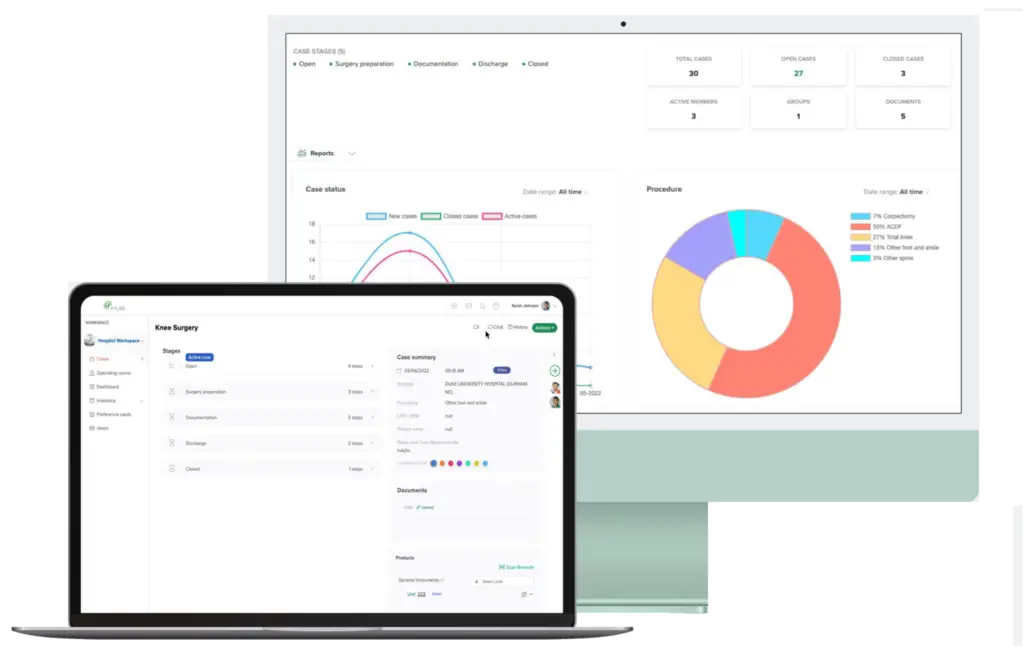Managing inventory is a crucial aspect of any business, but it is especially important in the medical device industry. With constantly changing regulations, high-value products, and strict expiration dates, medical device inventory management requires a unique approach.
In this article, we will discuss the best practices for medical device inventory management, including stock control, inventory optimization, and the use of technology to streamline the process.
Interactive Demo: HUB Healthcare Materials Management System
Why is Medical Device Inventory Management Important?
Effective inventory management is essential for the success of any medical device company. Here are some reasons why:
Cost Control
Cost control in medical device inventory management is not just a financial measure; it’s a strategic imperative that directly impacts a company’s bottom line and operational efficiency. Here’s how a well-orchestrated inventory system can significantly impact costs:
1. Capital and Resource Optimization: Medical devices are often high-value items, and excessive stock can tie up significant capital that could otherwise be used for innovation, marketing, or expansion. Efficient inventory management ensures an optimal stock level, freeing up capital and resources. For instance, consider Medtronic’s approach: By reducing inventory levels while maintaining supply chain integrity, they’ve managed to free up capital, which can be reinvested into R&D or other profit-generating activities.
2. Waste Reduction and Expiration Management: Medical devices often come with strict expiration dates. Poor inventory management can lead to expired products, which are not just financial losses but also potential risks to patient safety. Implementing the First-In, First-Out (FIFO) method and regular audits can significantly reduce waste. For example, if a company typically experiences a 5% loss due to expiration, improving tracking and management could save thousands to millions of dollars annually, depending on the scale of operations.
3. Enhanced Negotiation with Suppliers: With a clear understanding of inventory needs and patterns, companies can negotiate better terms with suppliers, such as bulk discounts or more favorable payment terms. This proactive approach was evident in Stryker’s JIT inventory strategy, which not only minimized storage costs but also potentially improved their bargaining position with suppliers, leading to cost savings.
4. Reduced Storage and Handling Costs: Excess inventory requires additional storage space and incurs higher handling costs. By optimizing inventory levels, companies can significantly reduce these costs. For instance, switching to a JIT inventory system might reduce the need for large warehouse spaces, thereby lowering rent, utilities, and insurance costs.
Real Data Impact: Consider the following hypothetical but realistic scenarios based on industry averages:
- By implementing inventory optimization software, a medium-sized medical device company reduces overstock by 20%. For a company with an average inventory value of $5 million, this equates to a $1 million reduction in tied-up capital.
- A company using advanced tracking and FIFO methods reduces its waste due to expiration by 50%, saving $250,000 annually based on previous average losses.
- Improved supplier negotiations, due to better inventory insight, lead to a 5% reduction in purchase costs, equating to savings of hundreds of thousands of dollars depending on the scale of purchases.
Compliance with Regulations
The medical device industry is heavily regulated, and companies must comply with strict guidelines for inventory management. This includes tracking expiration dates, lot numbers, and serial numbers for each product. Failure to comply with these regulations can result in fines and even product recalls.
Learn more about tracking compliance and regulations
Customer Satisfaction
In the medical device industry, customer satisfaction hinges on the ability to deliver the right product at the right time. Efficient inventory management plays a pivotal role in ensuring that this delivery is not just timely but also meets the highest standards of quality and reliability. Here’s a deeper look into how robust inventory management can enhance customer satisfaction:
1. Ensuring Product Availability: For healthcare providers, the availability of medical devices can be a matter of life and death. Effective inventory management ensures that essential products are always in stock, thereby avoiding critical stockouts that could delay surgeries or treatments. By accurately forecasting demand and maintaining optimal stock levels, companies can assure healthcare providers that the devices they need will be available whenever they are needed.
2. Improving Delivery Speed: When a medical device is needed, it’s often needed urgently. An efficient inventory system with streamlined picking, packing, and shipping processes can significantly reduce delivery times. For instance, integrating real-time inventory tracking with automated ordering systems can expedite the replenishment process, ensuring that products reach customers more quickly.
3. Enhancing Quality Control: Proper inventory management includes monitoring for damaged or defective items and ensuring they are quickly removed from circulation. This vigilance helps maintain high-quality standards, reducing the likelihood of faulty devices reaching a patient. Furthermore, by tracking lot and serial numbers, companies can quickly respond to any quality concerns and conduct targeted recalls if necessary, thereby protecting patient safety and maintaining trust.
4. Personalized Service: An advanced inventory system can help companies better understand their customers’ buying patterns and preferences, which can be used to provide more personalized service. For example, if a particular hospital frequently orders a specific type of device, the supplier can ensure that these items are always readily available or even offer automatic replenishment services.
5. Responding Proactively to Issues: With a robust inventory management system, companies can more quickly identify and address potential issues, such as a sudden increase in demand for a particular product or the impending expiration of a batch of devices. This proactive approach can prevent problems before they affect the customer, thereby maintaining a high level of service and satisfaction.
Real-World Impact:
- A study in the Journal of Business Logistics found that a 1% increase in product availability leads to a 2-3% increase in customer satisfaction scores.
- According to a report by the Aberdeen Group, companies with excellent supply chain capabilities enjoy customer satisfaction rates 10-20% higher than those of their peers.
Best Practices for Medical Device Inventory Management
Now that we understand the importance of inventory management in the medical device industry, let’s discuss some best practices for managing inventory effectively.
Implement Stock Control Measures
Stock control is the process of monitoring and managing inventory levels to ensure that they are neither too high nor too low. Here are some stock control measures that medical device companies should implement:
- Set Par Levels: Par levels are the minimum and maximum inventory levels that a company should maintain for each product. By setting par levels, companies can ensure that they have enough inventory to meet demand without overstocking.
- Use First-In, First-Out (FIFO) Method: In the medical device industry, products have expiration dates, and it is crucial to use the oldest products first to avoid waste. The FIFO method ensures that the oldest products are used first, reducing the risk of expired inventory.
- Track Lot and Serial Numbers: As mentioned earlier, medical device companies must track lot and serial numbers for each product. This allows for better traceability and helps in the event of a product recall.
- Conduct Regular Audits: Regular audits of inventory levels can help identify any discrepancies and ensure that inventory levels are accurate.
Optimize Inventory Levels
Inventory optimization is the process of finding the right balance between having enough inventory to meet demand and minimizing excess inventory. Here are some ways to optimize inventory levels:
- Analyze Sales Data: By analyzing sales data, companies can identify trends and forecast demand for each product. This allows for better inventory planning and can help prevent stockouts.
- Collaborate with Suppliers: Working closely with suppliers can help companies better manage lead times and ensure that they have the products they need when they need them.
- Consider Just-In-Time (JIT) Inventory: JIT inventory is a strategy where companies only order products as needed, reducing the risk of overstocking. However, this strategy requires close collaboration with suppliers and accurate demand forecasting.
- Utilize Technology: Inventory management software can help companies track inventory levels, expiration dates, and lot numbers more efficiently. This can save time and reduce the risk of human error.
Leverage Technology for Streamlined Inventory Management
In the realm of medical device inventory management, technology stands as the cornerstone of innovation, driving efficiencies and ensuring precision. With the advent of advanced solutions like HUB Healthcare, the landscape of inventory management is not just changing; it’s evolving into a more intelligent, responsive system.
Leveraging Technology for Advanced Inventory Management:
1. Smart Inventory Systems: Modern inventory management is about smart systems that offer real-time tracking and data analytics. HUB Healthcare exemplifies this by providing a platform where every piece of inventory is accounted for, from arrival to usage. This level of detail prevents overstocking and understocking, ensuring optimal inventory levels at all times.
2. Automated Reordering and Predictive Analytics: Automated reordering, powered by predictive analytics, is transforming how inventory is managed. Systems can now forecast demand based on historical data, seasonal trends, and real-time usage rates, automatically triggering reorder points to prevent stockouts. HUB’s platform integrates these capabilities, offering a proactive approach to inventory management.
3. RFID and Barcode Technology: Radio-frequency identification (RFID) and barcode technology have revolutionized inventory tracking. Items can be scanned and recorded into inventory systems like HUB in seconds, providing up-to-date information on stock levels, locations, and movements throughout the facility.
4. Integration with Clinical Systems: Integrating inventory management systems with clinical systems ensures a seamless flow of information. HUB’s ability to integrate means that inventory data can inform clinical decisions, and vice versa, ensuring that the supply always meets the clinical demand.
5. Mobile Technology: Mobile applications allow for on-the-go management and monitoring of inventory. HUB’s mobile-friendly interface means that managers can access inventory data, receive alerts, and make decisions from anywhere, enhancing responsiveness and flexibility.
The Future of Medical Device Inventory Management:
As we look to the future, several emerging trends and technologies are set to further revolutionize inventory management:
1. Internet of Things (IoT): IoT devices are beginning to play a more significant role in inventory management, offering real-time tracking and monitoring of inventory conditions, such as temperature and humidity, which are crucial for sensitive medical devices.
2. Machine Learning and AI: These technologies promise to bring predictive accuracy to a new level, analyzing vast amounts of data to optimize inventory levels, predict equipment failures before they occur, and even suggest the most efficient inventory layout.
3. Blockchain for Traceability: Blockchain technology could provide an immutable ledger for the medical device supply chain, offering unprecedented traceability and security from the manufacturer to the end-user.
4. 3D Printing: In the future, some medical devices or parts could be printed on-demand in healthcare facilities, drastically reducing the need for large inventories and transforming the entire supply chain.
By leveraging these technologies and embracing innovative platforms like HUB Healthcare, medical facilities can not only streamline their inventory management processes but also enhance their overall operational efficiency and patient care quality. The future of inventory management is here, and it’s smarter, more integrated, and more responsive than ever before.
Who is Responsible for Medical Device Inventory Management?
Inventory management in the medical device industry is a collaborative effort that requires coordination across several departments. While the primary responsibility often lies with the supply chain or operations team, it’s vital for sales, marketing, and even clinical teams to contribute their insights.
The supply chain team typically oversees the direct management of inventory, ensuring levels are maintained, orders are placed, and stock is rotated effectively. Meanwhile, the sales and marketing teams provide essential information on customer demand, market trends, and product performance, which are crucial for accurate forecasting and inventory optimization.
Furthermore, in some organizations, clinical teams may also play a role, especially when it comes to understanding the specific needs and usage rates of medical devices. Their input can help ensure that inventory meets the actual needs of healthcare providers and patients.
Ultimately, effective medical device inventory management requires a unified approach, with clear communication and shared objectives among all the key players involved. This integrated effort helps ensure that the right products are available at the right time, enhancing overall efficiency and customer satisfaction.
Conclusion
Effective inventory management is crucial for the success of any medical device company. By implementing stock control measures, optimizing inventory levels, and leveraging technology, companies can streamline their inventory management process and improve efficiency.
By following best practices and learning from real-world examples, medical device companies can ensure that they have the products their customers need when they need them, leading to higher customer satisfaction and increased profits.








